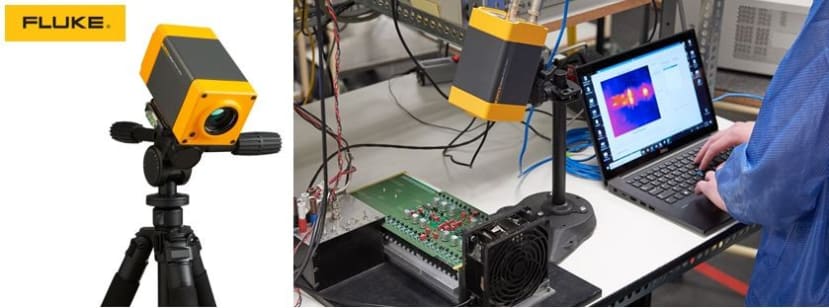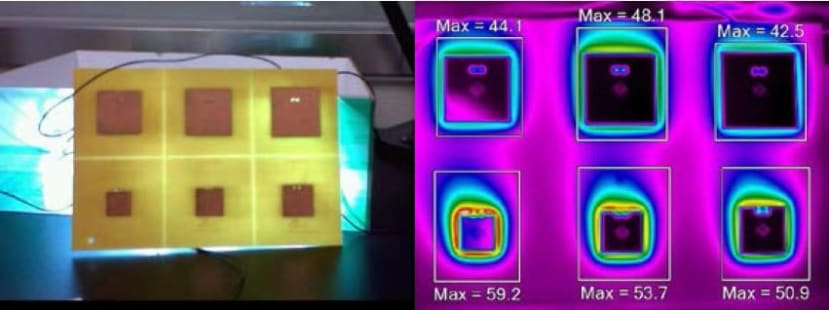Taking the Heat out of your Designs
Follow articleHow do you feel about this article? Help us to provide better content for you.
Thank you! Your feedback has been received.
There was a problem submitting your feedback, please try again later.
What do you think of this article?
Minimizing the heat within any printed circuit board design is critical, as excess temperature can reduce the operating life of the components and cause potential failure, however making physical connections to the circuit board to monitor temperature can impact the operation of the circuit and the measurement taken, however the Fluke RSE300 and RSE600 mounted infrared cameras provide the solution with enhanced thermal details.
The Fluke RSE series are fully-radiometric mounted infrared cameras that are equipped with software plug-ins for MATLAB® and LabVIEW® so continuous infrared data can be collected and analyzed, so whether you’re designing or testing printed circuit board prototypes, developing new products or new product materials, these thermal imagers can play a key role to measure and monitor temperature, heat dissipation, latent heat to reveal countless potential problems at an early stage in the development process and hence help ensure quality and avoid future failures.
Take a quick look at this short introduction video for the RSE Series:
The RSE Series are an ideal tool for both scientific research and the early / late stages of circuit development and troubleshooting, but as mentioned earlier there is no physical contact, so collecting thermal data avoids any interference with the operation / process (which could happen with other measurement means such as RTD temperature probes), but along with this far more simultaneous data points can be collected with the infrared camera than could be achieved with thermal probes, so monitoring the operation and thermal performance of the circuit under tests can be more closely monitored under varying operating parameters.
The Fluke RSE series not only gives you the detail and accuracy you need to identify thermal anomalies in circuit board components, but can also track phase changes in injection mold manufacturing and analyzing non-destructive testing of multilayer composites or carbon fiber components, so making these cameras versatile in design or production facility.
The key benefits include:
- High degree of accuracy
- Excellent spatial and measurement resolution
- High thermal sensitivity and responsive performance
- High resolution coupled with optional macro lenses can provide for up-close imaging capabilities that produce highly detailed and informative images, with apparent temperature calculations for each pixel.
- Individual images can provide a wealth of data on their own, however capturing multiple images or streaming radiometric data and the mountain of data increases exponentially.
- MultiSharp™ Focus, eliminates potential miss-diagnosis with automatically focused images
- Easily access the data from the included SmartView® software - which can be exported
- Plug-ins for MATLAB® and LabVIEW® allows the leverage of these software platforms to analyze high resolution infrared data (Click this link to visit Fluke’s download page)
Typical Example
As an example Fluke’s application note in the download area at the bottom of this page, details how these cameras were used to measure the LED chip heat dissipation mapping and the importance of heat sinks, because the LED chip is the core components within LED lighting, where if the operating temperature is too high, then the LED life and luminous quality could be severely affected, so using these cameras and improve both the efficiency and life expectancy.
Top 6 applications for the RSE infrared cameras:
- Electronics research and development Finding localized over- temperature issues • Characterizing the thermal performance of components, conductors and semi-conductor substrates • Establishing appropriate cycle times • Analyzing assembly impact • Validating thermal modeling projections • Assessing collateral damage due to proximate sources of heat
- Materials engineering Phase change analysis • Residual or repeated thermal stress analysis • Non-destructive testing including inspection and analysis of delamination, voids, moisture inclusion, and stress fracturing of composite materials • Surface radiance analysis
- Chemical and Biosciences Monitoring exothermic and endothermic chemical reactions • Analyzing biological processes • Environmental impact monitoring and analysis • Plant and vegetation research
- Product design and validation Characterization of product thermal performance • Characterization of material properties in a product • High-speed monitoring and analysis of product thermal performance
- Geothermal, geological, and earth sciences Monitoring and analysis of geothermal formations and processes • Volcanic research
- Aerodynamics and aeronautics Characterization and analysis of laminar flow • Non-Destructive Testing (NDT) of composite materials and structures • Stress and deformation analysis • Propulsion system performance analysis
The Fluke RSE series are available from RS:
- Fluke RSE300 infrared camera – 320x240 resolution (175-6966)
- Fluke RSE600 infrared camera – 640x480 resolution (175-6967)





